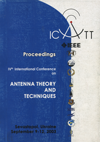Aperture antenna radiation
DOI:
https://doi.org/10.1109/ICATT.2003.1239144Keywords:
Fourier transforms, antenna radiation patterns, aperture antennas, finite difference time-domain analysis, finite element analysis, method of moments, wavelet transformsAbstract
The technique that can be applied to the calculation of aperture antenna radiation patterns is the equivalence principle followed by physical optics. The equivalence principle is based on replacing the physical antenna aperture with a virtual antenna aperture consisting of an ensemble of Huygen's sources, each of which is a source of spherical wavelets. The total pattern is taken as a construction of these Huygen's secondary waves. A Fourier transform relation exists between the amplitude distribution of these sources, and the radiation pattern in angle space.
For most aperture antenna problems, these classical techniques are adequate and give reasonably accurate results. However, more modern analysis techniques such as method of moments (MOM), finite element method (FRM), and the finite difference time domain (FDTD) method are also discussed. These are more robust and accurate, but the complexity and large amount of computer resources required must be traded off with the accuracy desired.
References
Kozakoff, D.J. Analysis of radome enclosed antennas. Artech House Publishers, Norwood, MA, 1997.
Schelkunoff, S.A. Some equivalence theorems of electromagnetics and their application to radiation problems. Bell System Tech. J., 15: 92-112, 1936.
Huygens, C.; Traite de La Lumiere, Leyden, 1690. Translated into English by S. P. Thompson, Chicago, Il, University of Chicago Press, 1912.
Kraus, J.D.; Carter, K.R. Electromagnetics, 2nd ed. New York: McGraw-Hill Book Company, pp. 464-467.
Sommerfeld, A.; Theorie der Beugung, in P. Frank and R. von Mises (eds.), Die Differential und Integralgleichungen der Mechaniik und Physik, Braunschweig, Germany: Vieweg, 1935.
Balinis, C.A. Antenna Theory Analysis and Design. New York: Harper and Row Publ., 1982.
Oliver, A.D. Basic Properties of Antennas, in A. W. Rudge, et al. (eds.), The Handbook of Antenna Design, IEE Electromagnetic Wave Series UK, London: UK, Peter Peregrinum Publ., 1986, Ch. 1.
Jasik, H. Fundamentals of Antennas, in R. C. Johnson (ed.), Antenna Engineering Handbook, 3rd ed. New York: McGraw Hill Book Company, 1993.
Kraus, J.D. Antennas, 2nd ed., New York: McGraw Hill Book Company, 1988.
Booker, H.G.; Clemmow, P.C. The Concept of an angular spectrum of plane waves and its relation to that of polar diagram and aperture distribution. Proc. of IEEE, London, UK, Ser, 3, 97: 11-17, 1950.
Rhodes, D.R. The optimum line source for the best mean square approximation to a given radiation pattern. IEEE Trans. On Antennas and Propag., Vol. AP-11, p. 440-446, 1963.
Elliot, R.S. Antenna Theory and Design. Englewood Cliffs, NJ: Prentice Hall Book Company, 1987.
Sokolnikoff, I.S.; Redhefer, R.M. Mathematics of Physics and Modern Engineering. New York: McGraw Hill Book Company, 1958.
Silver, S. Microwave Antenna Theory and Design. New York: McGraw Hill Book Company, 1949.
Volakis, J.L.; Chatterjee A.; Kempel, L.C. Finite Element Methods for Electromagnetics. IEEE Press, New York (ISBN 0-7803-3424-6) and Oxford University Press, London (0-10-850479-9) 1998.
Sylvester, P.P.; Pelosi, G. (eds.), Finite Elements for Wave Electromagnetics: Methods and Techniques. IEEE Press, New York, 1994.
Sylvester, P.P.; Ferrari, R.L. Finite Elements for Electrical Engineers. New York: Cambridge University Press, 1992.
Jin, J. The Finite Element Method in Electromagnetics. New York: John Wiley InerScience, 1993.
Harrington, R.F. Field Computation by Moment Methods. New York: MacMillan Company, 1968.
Miller, E.K.; Medgyesi-Mitschang, L.; Newman, E.H. (eds.), Computational Electromagnetics, Frequency Domain Method of Moments. IEEE Press, New York, 1992.
Hansen, R.C. (ed.), Moment Methods in Antennas and Scattering. Artech House, Norwood, MA (ISGN 0890064660), 1990.
Taflove, A. Computational Electromagnetics: The Finite Difference Time Domain Method. Norwood, MA: Artech House, 1995.
Kunz, K.S.; Luebbers, R.J. The Finite Difference Time Domain Method for Electromagnetics. Cleveland, OH: CRC Press, 1993, ISBM 0949386578.
Chun, D.; Simons, R.N.; Kotehi, L.P.B. Modeling and Characterization of Cavity Backed Circular Aperture Antenna with Suspended Stripline Probe Feed. IEEE Antennas and Propagation Society Int. Symp., 2000, Digest, Salt Lake City, UT, 2000.
Lee, J.Y.; Horng, T.S.; Alexopoulos, N.G. Analysis of Cavity Backed Aperture Antennas with a Dielectric Overlay, IEEE Trans. on Antennas and Propag., Vol. 42, No. 11, Nov. 1994, pp. 1556-1562.
Sullivan D.; Young, J.L. Far-Field Time-Domain Calculation from Aperture Radiators Using the FDTD Method. IEEE Trans. Antennas and Propag., Vol. 49, No. 3, Mar. 2001, pp. 464-469.
Ensemble Software, Version 6.1, Ansoft Corp., Four Station Square, Suite 200, Pittsburgh, PA 15219, Tel. 412-261-3200.
HFSS, Ansoft Corp., Four Station Square, Suite 200, Pittsburgh, PA 15219, Tel. 412-261-3200.
Altman, Z.; Mittra, R. Combining an Extrapolation Technique with the method of Moments for Solving Large Scattering Problems Involving Bodies of Revolution. IEEE Trans. Antennas Propag., Vol. 44, No. 4, Apr. 1996, pp. 548-553.
Greenwood, A.D.; Jin, J.M. Finite Element Analysis of Complex Axisymmetric Radiating Structures. IEEE Trans. On Antennas and Propag., Vol. 47, No. 8, Aug. 1999, pp. 1260.
Putman, J.M.; Medgyesi-Mitschang, L.N. Combined Field Integral Equation for Inhomogeneous Two- and Three-Dimensional Bodies: The Junction Problem. IEEE Trans. On Antennas and Propag., Vol. 39, No. 5, May 1991, pp. 667-672.

